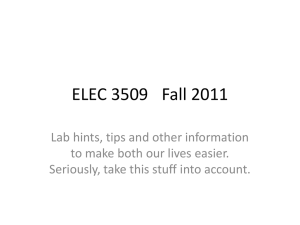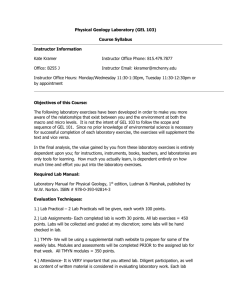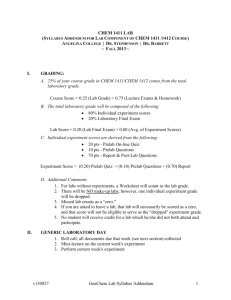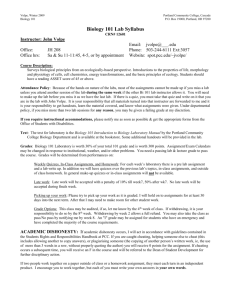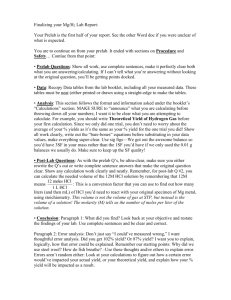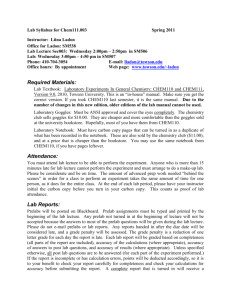geos 101x: " the dynamic earth"
advertisement
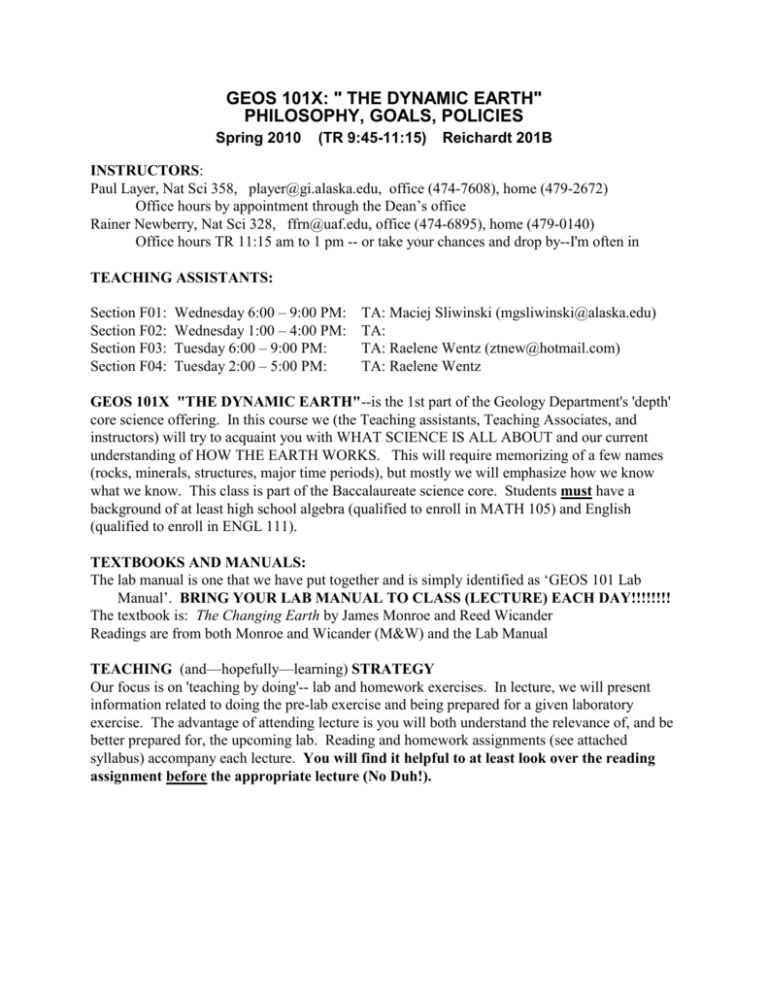
GEOS 101X: " THE DYNAMIC EARTH" PHILOSOPHY, GOALS, POLICIES Spring 2010 (TR 9:45-11:15) Reichardt 201B INSTRUCTORS: Paul Layer, Nat Sci 358, player@gi.alaska.edu, office (474-7608), home (479-2672) Office hours by appointment through the Dean’s office Rainer Newberry, Nat Sci 328, ffrn@uaf.edu, office (474-6895), home (479-0140) Office hours TR 11:15 am to 1 pm -- or take your chances and drop by--I'm often in TEACHING ASSISTANTS: Section F01: Section F02: Section F03: Section F04: Wednesday 6:00 – 9:00 PM: Wednesday 1:00 – 4:00 PM: Tuesday 6:00 – 9:00 PM: Tuesday 2:00 – 5:00 PM: TA: Maciej Sliwinski (mgsliwinski@alaska.edu) TA: TA: Raelene Wentz (ztnew@hotmail.com) TA: Raelene Wentz GEOS 101X "THE DYNAMIC EARTH"--is the 1st part of the Geology Department's 'depth' core science offering. In this course we (the Teaching assistants, Teaching Associates, and instructors) will try to acquaint you with WHAT SCIENCE IS ALL ABOUT and our current understanding of HOW THE EARTH WORKS. This will require memorizing of a few names (rocks, minerals, structures, major time periods), but mostly we will emphasize how we know what we know. This class is part of the Baccalaureate science core. Students must have a background of at least high school algebra (qualified to enroll in MATH 105) and English (qualified to enroll in ENGL 111). TEXTBOOKS AND MANUALS: The lab manual is one that we have put together and is simply identified as ‘GEOS 101 Lab Manual’. BRING YOUR LAB MANUAL TO CLASS (LECTURE) EACH DAY!!!!!!!! The textbook is: The Changing Earth by James Monroe and Reed Wicander Readings are from both Monroe and Wicander (M&W) and the Lab Manual TEACHING (and—hopefully—learning) STRATEGY Our focus is on 'teaching by doing'-- lab and homework exercises. In lecture, we will present information related to doing the pre-lab exercise and being prepared for a given laboratory exercise. The advantage of attending lecture is you will both understand the relevance of, and be better prepared for, the upcoming lab. Reading and homework assignments (see attached syllabus) accompany each lecture. You will find it helpful to at least look over the reading assignment before the appropriate lecture (No Duh!). You (the student) will do the pre-lab exercise both to acquire the background and to show us how well you understand the background to the lab. This allows us to spend the laboratory period doing the lab exercise rather than lecturing about it. Depending on the lab, you may finish it all in the lab period, or you might need to write up an overview question later, after lab. Finally, to make sure that you understand the topic we present in lab and lecture, you will do a homework problem that will be due after you’ve completed the laboratory exercise for the associated topic. There are no quizzes or midterms in this class because you will be continuously showing us that you do understand each topic—or where you need help. To pass this course, you will need to complete --in a timely manner--13 (of 14) homework, 13 (of 14) laboratory exercises, and the Final Essay. You must also attend class (and participate in the In-class exercises). YOU MUST ATTEND THE FINAL TWO LABS (FIELD TRIPS). The field trips are critical because this is where you really see the relevance of what we’ve presented concerning geology and the earth. We encourage you to work in groups for the labs (if you enjoy doing so) but to use your own words and to NOT copy anyone else's work!!!! Please refer to the Student Code of Conduct on pages 47-48 of the 2009-2010 UAF Catalog. If you have a documented disability that requires additional time on homework assignments or labs, or if you require other accommodation, please let us know within the first two weeks of the semester. The Office of Disability Services implements the Americans with Disabilities Act (ADA), and insures that UAF students have equal access to the campus and course materials. We will work with the Office of Disabilities Services (203 WHIT, 474-7043) in order to provide reasonable accommodation to students with disabilities. The key is that if you are having problems in the class, see us ASAP and we will try to help you. LABS The first labs will meet Tuesday and Wednesday, January 26 and 27. Written laboratory reports from a given week are due at the start of the following week's lab. A weekly “pre-lab exercise” is due IN LECTURE at the start of class each Tuesday, and is worth 10% of the lab grade. If you do not turn in the exercise IN LECTURE, your grade for the lab will be “docked” 10 points (out of 100). The purpose of the pre-lab is to get you ready for the lab exercise; the reason for turning it in at Lecture is to give the TAs a chance to go over them and see where you need help before the lab starts. Our Thursday lectures should provide the information you need to do the prelab before the Tuesday class. If, after coming to the Thursday lecture, you are still unsure about the prelab questions, consider coming to the Sunday afternoon sessions (which will require advance planning on your part) and (or) contacting (emailing?) your T.A.or an instructor. Additional notes concerning Labs: 1. Plan to bring your lab manual, a pencil, paper, and a calculator to each lab session. 2. You can make up a missed lab if and only if you have notified your TA before the lab you will miss and arrange at that time when you will do it. Some labs require extensive set-up and your TA may not be able to prepare a lab especially for you on short notice. 3. It is possible to attend the “wrong” lab section with approval from the appropriate TA, however make sure that you are registered for the lab time that you attend most often. 4. We will make every attempt to promptly return graded lab and homework exercises; consequently, we cannot accept materials turned in grossly late... 5. Lab sections are 3 hours long. We have designed these labs to run the full time for students who have attended lecture, completed the pre-lab, and have read the lab manual. If you aren’t prepared it’s likely to take you SIGNIFICANTLY longer than 3 hours or you will not finish it at all. Please come prepared. HOMEWORK Exercises are assigned on Thursday and due the following Thursday at the start of lecture. We urge you to set aside a regular time each week to work on homework and pre-lab assignments. The assignments are designed so that you can work on them over the weekend. The due date is such that you will have an opportunity to consult with your TA about the homework exercise. Also consider the Sunday afternoon help sessions. HOMEWORK HELP SESSION: SUNDAYS 2 – 5, ROOM 230 (THE LAB) IN-CLASS EXERCISES Throughout the semester we will be asking a short ‘question of the day’ in class. You will be given a 3x5 card and on that card you will put your name (clearly so we can read it) and the answer to the ‘question of the day’. We will collect those cards during class and look them over as a way to gauge attendance and to see if the class as a whole has ‘gotten’ the topic we are talking about. (We view this as sort of a low-tech clicker system). GRADING POLICY : As stated above, you must complete 13 of the 14 homeworks and 13 of the 14 labs. This gives you the opportunity to miss a week or to drop the lowest grade. YOU MUST ATTEND THE FINAL TWO LABS (FIELD TRIPS). All homework and lab reports, and the Final Essay must be handed in by 10:00 AM May 10. 13 homeworks 13 labs Final Essay In-class exercices ----- 30% of grade 60% of grade 5% of grade 5% of grade If you are missing more than 2 homeworks or labs prior to drop date (February 5) or withdrawal date (March 26) you will receive (copy to your advisor) a written request to drop the course. We may exercise the option to drop you from the course if you’ve done minimal work, but don’t count on it unless you don’t mind getting an ‘F’. Late Policy: Any lab report or homework handed in after the due date will be docked at least 10%. Homework or lab reports handed in after the graded assignment has been returned to the rest of the class will be docked 50%. [Exceptions: documented illness, etc. If in doubt, talk to one of us.] Lab reports not submitted will receive a grade of 0%, even if you attended the lab. Remember that the lowest one lab and one homework grade will be dropped, so if you miss one deadline, it’s not going to be a disaster. Making a habit of doing so, however, will be a disaster. Plagiarism Policy: It is fine to work with other students, but you must use your own words in answering a question. If two or more students hand in essentially identical lab or homework exercises, we will investigate and probably give at least one of the students a score of 0 %. General grading guidelines/predictors (what you can do to earn a grade in this class) A = All required homework, prelabs, and lab reports turned in on time and done to a high level. B = All required homework, prelabs, and lab reports turned in (most on time) with good quality answers. C = All required lab reports turned in, but some with low grades. Missing or poor quality homework. D = Attend all labs, but missing a couple of lab reports, poor quality or missing homework. F = Failure to attend labs, turn in lab reports and homework. We will be using the +/- grading option to better evaluate borderline cases. A final word of advice: Attendance at lectures is required and will be assessed in the in-class exercises. Further, it is our experience that students who regularly attend lecture are more apt to turn in their pre-labs and homeworks on time, be better prepared for lab (so they can get through in the allotted time), and get higher grades for the class. We will use the lectures to discuss homework and prelabs and will occasionally have ‘extra credit’ in-class exercises. THE MOST IMPORTANT THINGS Attend Class Bring your lab manual to class and lab each day. Do the required reading before class. Work on the Prelab BEFORE it is due on Tuesday Hand in assignments ON TIME Ask questions if you do not understand something or have problems with the class. Take advantage of Office Hours for the instructors and TAs Feel free to ask questions and participate in discussions IN CLASS HAVE FUN!!!!!!!!!!! GEOS 101 Syllabus, Readings and Assignments, Spring 2010 Week Lecture 1 1 2 3 4 5 6 7 Date 1-21 M&W Lecture topic Introduction, course outline, intro to maps and the earth, Earth coordinate systems Homework/Prelab Due Lab exercise 2 1-26 App. B Topographic maps, topographic profiles Prelab 1- Topo maps 1. Understanding Topographic Maps 3 1-28 Ch 8 Properties of materials, seismic waves HW-1 Diagnostics and Rules 4 2-2 Ch 8 Prelab 2 -earthquakes 5 2-4 Ch 3 Earth structure, locating earthquakes, earthquakes in Alaska Mineralogy I: systematic identification; compositions 6 2-9 Ch 3 Mineralogy II: principles & structures Prelab 3 –Minerals 7 2-11 51-52 451-458 Chemical compositions, X-rays, intro to radioactivity and heat HW-3 Earthquakes and Waves 8 2-16 Geochronology, Introduction to melting Prelab 4 – Analytical 9 2-18 451-458 Ch 4 Ch 4 Igneous melts: character, origins, some I.D. HW-4 Minerals 10 2-23 Prelab 5-Igneous rocks 11 2-25 Igneous rock identification; plutons & volcanoes Magnetism and the earth 12 3-2 Ch 1 Ch 4 Ch 5 Ch 2 Ch 2 Ch 10 Ch 6 2. Earthquakes and Seismic Waves HW-2 Topographic Maps 3. Mineralogy and Mineral Identification 4. Analytical Methods 5. Igneous rocks & Processes HW-5 Compositions and Ages Paleomagnetism & continental drift, faults and Prelab 6 -magnetism 6. Earth Magnetism & faulting Faults 13 3-4 Weathering, Seds & sed rocks HW-6 Igneous Rocks SPRING BREAK Week of March 8-12 Homework exercises or Prelabs are due IN CLASS on the specified day M&W = the Monroe and Wicander text book Week Lecture 8 14 Date 3-16 157-160 15 3-18 9 16 17 10 11 12 13 14 15 M&W Homework/Prelab Due Prelab 7- Sed rocks Ch 12 Lecture topic Seds, fossils, environments, and age of the Earth Streams & ground water I: principles 3-23 3-25 Ch 12 Ch 7 Ground water II: Alaskan examples Metamorphic processes and facies Prelab 8-Hydrology HW-8 Sedimentary Rocks 8. Subsurface hydrology 18 3-30 Ch 7 Prelab 9-Meta. rocks 9. Metamorphism & Metamorphic rocks 19 4-1 Metamorphic rock identification; general rock identification; folds and fold nomenclature Stratigraphic concepts; geologic units & their orientations; geologic maps 20 4-6 Prelab 10-Geol. maps 21 4-8 Structural geology— faults & folds & environments they form in, map symbols Big scale structural geology 22 4-13 Examples of Alaskan geology & tectonics 11. Faults, faulting, and geologic maps 23 4-15 Air photos & Remote sensing Prelab 11- Earthquakes and Faults in Alaska HW-11 Geologic Mapping 24 4-20 Glaciers I: intro, glacial erosion & deposits Prelab 12: Air photos 12. Air Photos & remotely sensed images 25 4-22 Glaciers II: ice ages—causes & effects HW-12 Global seismicity and geologic cross section 26 4-27 Origins of coal and oil Prelab 13-Field trip 1 27 4-29 Oil in Alaska: the ANWR debate HW-13 Glacial velocities 28 5-4 Prelab 14-Field trip 2 29 5-6 Interior Alaskan geology, with particular reference to field trip II; Science & Religion? Oral and written student feedback Ch 10 Ch 14 161-162 Lab exercise 7. Sedimentary rocks & processes HW-7 Magnetism HW-9 Hydrology 10. Geologic Maps & geologic mapping HW-10 Metamorphic Rocks HW-14 mapping a petroleum trap 5 pm May 11 (Tuesday) ---Final Essay is due. (3:15-5:15 pm Tues is the scheduled exam time for this class) Homework exercises or Prelabs are due IN CLASS on the specified day M&W = the Monroe and Wicander text book 13. Field Trip I: rocks & their characteristics 14. Field trip II: structures & geol maps
